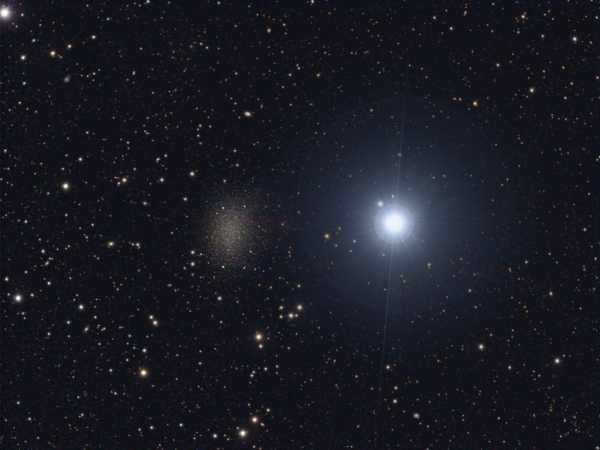
When gazing at the night sky in spring, even those without much knowledge in astronomy can easily spot three prominent stars – Arcturus, Spica, and Regulus.
Regulus is considered the royal figure of the celestial realm
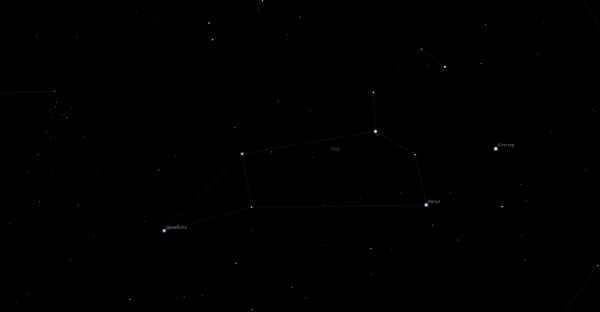
Regulus, also known as Alpha Leonis, is the brightest star in the constellation Leo. It is most visible during the spring season when the night sky is less crowded with other bright stars compared to the summer. Observing Regulus in the summer can be challenging due to its proximity to the ecliptic, which occasionally results in its obstruction by the Moon.
Resources related to the subject
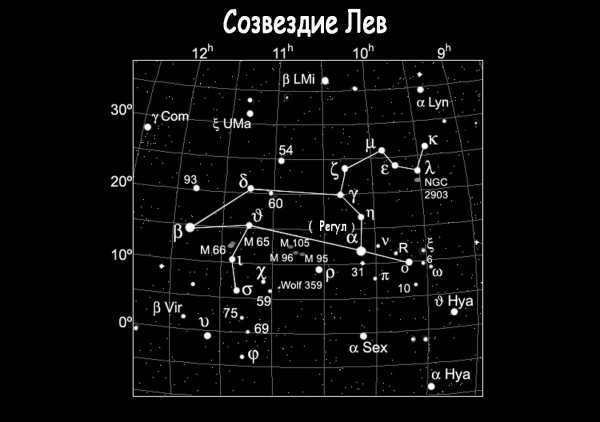
The constellation Leo is the primary constellation that dominates the spring sky.
However, during the spring season, when Regulus is located far from the ecliptic, it remains distinguishable amidst the numerous stars, even to the unaided eye. This is primarily due to the star’s remarkable luminosity.
Etymology and Discovery
Due to its status as the most luminous star in the Leo constellation, it is commonly referred to as Alpha Leo. This moniker aligns with its astronomical label “α Leo,” which serves as its widely recognized astronomical name.
The distinctive form and rapid rotation of the star
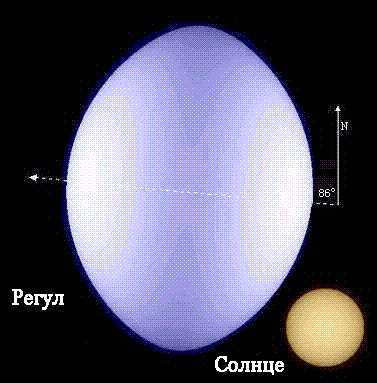
The star Regulus is of great interest to amateur astronomers due to its exceptional brightness and unique shape. Unlike other stars, Regulus rotates at an astonishing speed of 315 km/s, which is 150 times faster than our Sun. This rapid rotation has caused the star to become flattened, with its equatorial radius being nearly 1/3 larger than its polar radius. In fact, Regulus completes a full rotation in less than 16 hours.
What’s fascinating is that if Regulus were to rotate just 14 percent faster, at 359.1 km/s, the centripetal gravitational force would not be sufficient to maintain the star’s structural integrity, resulting in its collapse. This highlights the delicate balance between gravitational forces and rotational speed that determines the shape and stability of celestial bodies like Regulus.
Regulus is a unique star because its axis of rotation is tilted, giving it a distinct appearance when observed from Earth. The high speed of its rotation causes the pole region to be about half as hot as the equator and five times brighter. Interestingly, the axis of rotation of Regulus aligns with its orbital line, resulting in the star moving along its orbit as if on its side. This creates a fascinating astronomical phenomenon that sets Regulus apart from other stars.
Weight and years
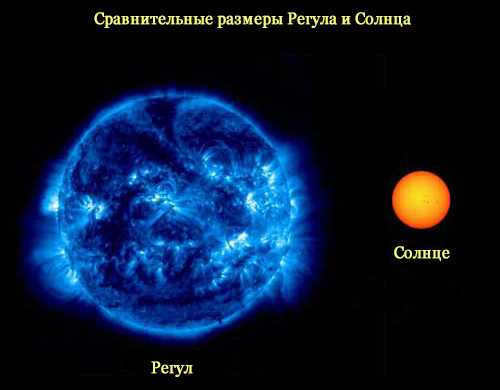
Comparing the size of Regulus to the Sun
According to modern physicists and astronomers, Regulus is considered to be a significantly larger star. It is generally agreed upon that Regulus has a mass three and a half times that of the Sun.
The age of Regulus, however, has been a subject of debate among scientists. It was previously believed that Regulus was no more than 100 million years old, indicating it as a young star. However, in 2008, the discovery of a dwarf star called Regulus D in close proximity to Regulus challenged this notion. This finding led scientists to reconsider and suggest that Regulus is much older than previously believed.

Ways to Identify Regulus in the Night Sky
Locating Regulus is a straightforward task due to its status as one of the most luminous stars visible at night. Found within the Leo constellation, Regulus serves as the foundation for the well-known asterism known as the “Sickle,” which can be easily identified in the Northern Hemisphere. Simply direct your gaze upwards, and you will notice a grouping of stars that resembles either a sickle or an inverted question mark. Positioned at the lowest point of this distinctive “Sickle” formation is the star Regulus.
Dear readers of Astrodata portal, we appreciate your support in reading our articles. Today, I have prepared an informative piece on the fixed stars in astrology. Let me explain how you can identify from a person’s horoscope, whether they are destined for a special purpose. We often hear the expression “born under a lucky (or unlucky) star”. Have you ever wondered why the term “star” is used instead of “planet”?
When it comes to fixed stars, one can delve into the subject for a whole series of lectures and be captivated by studying astrology and the unique ways in which the force of fixed stars manifests in our lives. Fixed stars come in various magnitudes and can be categorized based on their specific manifestations:
- Lucky stars
- Fatal stars (unlucky stars)
- Royal stars (stars of greatness)
Among these categories, the royal stars stand out as an especially powerful group of fixed stars.
Amidst the vast array of astrological splendor, there is a distinguished group known as the Royal Stars. These celestial beings bestow upon the horoscope an abundance of positive energy and a multitude of extraordinary opportunities for success in life. Such grandeur can only be sustained by those deserving of a royal status. Hence, they are aptly named the Royal Stars. In ancient times, astrologers relied on these stars to ascertain the rightful heir to the throne among multiple contenders.
However, let’s divert our attention to your horoscopes. Do you possess any specific indications of extraordinary potential? To satisfy your inquisitiveness, I will compile a roster of illustrious fixed stars of the highest magnitude – consult astrologers during sessions to ascertain if these stars align within your horoscopes or within the horoscopes of your offspring (it is imperative to determine if you do not occupy these degrees in the Luminaries or at the angular points of the horoscopes?
Aldebaran – 09 Gemini, Spica – 23 Libra Regulus – 29 Leo, Pollux – 23 Cancer, Antares – 09 Sagittarius, Zuben Elgenuby – 15 Scorpio
For those clientele who partake in my consultations in Riga, I am likewise delighted to address these inquiries and I will additionally examine these degrees.
At the very least, one more article elucidating the significance and peculiarities of fixed stars can be found on our website. You may peruse it here
Description of the star Regulus

Regulus is not actually a standalone star, but rather a system composed of 4 celestial bodies, with 2 being the primary ones. It has a mass that is 3.5 times greater than that of the Sun and a diameter that is nearly 4 times larger. This star is the brightest in its constellation, hence its name Alpha Leo. Regulus is a fixed star, meaning it is located directly on the ecliptic and rises and sets on the same days at almost all latitudes (excluding the polar regions). The best time to observe Regulus is during the spring, when there are fewer bright stars in the night sky compared to the summer. Scientists estimate that Regulus is an ancient star, with an age exceeding 900 million years.
Characteristics[edit edit code]
Regulus possesses distinct characteristics that set it apart from other stars. Firstly, it has a mass that is approximately 3.5 times greater than that of the Sun. Additionally, Regulus is relatively young, with an age of just a few hundred million years. This youth is reflected in its rapid rotation, with a period of only 15.9 hours. As a result of this fast rotation, the star takes on a unique shape, resembling a flattened pumpkin. The equatorial radius of Regulus is one-third larger than its polar radius, resulting in a gravitational darkening effect. This phenomenon causes the poles of the star to be significantly hotter and five times brighter per unit surface area than the equator. Interestingly, if Regulus were to rotate just 14% faster, the centripetal gravitational force would be insufficient to prevent the star from collapsing. Furthermore, the axis of rotation of Regulus aligns closely with its direction of motion in space. It is also worth noting that the axis of rotation is perpendicular to the beam of vision, meaning that observations of Regulus are made from a unique perspective[2].
The star possesses two tiny faint companions which form a binary system. These stars are separated by approximately 100 astronomical units and revolve around their mutual center of gravity over a span of 2000 years. In addition, this pair is situated at a distance of about 4,200 astronomical units from the massive Regulus A and completes an orbit around the main star within a time frame of 130,000 years.
Located 20 arc minutes[3] north of Regulus in the celestial sphere is the dwarf spheroidal galaxy Leo I, which was first discovered as a satellite of the Milky Way in 1950.
Distinctive Qualities
Regulus possesses several unique characteristics. It boasts a mass approximately 3.5 times greater than that of the Sun and is considered a relatively young star, with an age of just a few hundred million years. The star exhibits an exceptionally rapid rotation period of a mere 15.9 hours, resulting in a highly flattened shape resembling that of a pumpkin, with its equatorial radius being one-third larger than its polar radius. This remarkable shape gives rise to gravitational darkening, wherein the poles of the star are notably hotter (50% hotter, to be exact) and five times brighter (per unit surface area) than its equator. It is worth noting that if Regulus were to rotate just 14% faster, the centripetal gravitational force would fail to counteract the inward gravitational force, leading to the star’s collapse. The axis of rotation of Regulus aligns closely with the star’s motion through space, and it has been determined that the axis of rotation is perpendicular to the line of sight. Consequently, our observation of Regulus is from a unique viewpoint on the edge[2].
Located 20 arc minutes[3] to the north of Regulus in the sky lies Leo I, a dwarf spheroidal galaxy that was first discovered in 1950 and is a satellite of the Milky Way.
What makes this story significant is its revelation of the underlying legend that lies behind the military honors and triumphs associated with the star Regulus. Just like the other three royal stars, individuals who have Regulus in their birth chart have the potential to attain remarkable success, but only after undergoing a particular and inevitable trial. In the case of Regulus, that trial takes the form of seeking revenge.
Anomalous star shape and rapid rotation
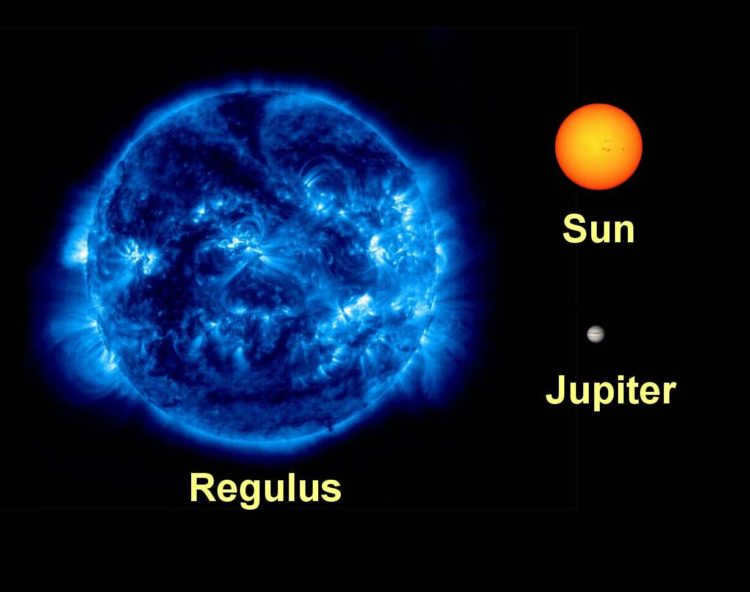
The star Regulus is of great interest to amateur astronomers not only because of its extraordinary brightness, but also because of its unique shape. With a rotation speed of 315 km/s (which is 150 times faster than that of our Sun), Regulus has a flattened shape – its equatorial radius is nearly one-third larger than its polar radius. Due to its high rotation speed, Regulus completes one full rotation in less than 16 hours. What’s fascinating is that if Regulus were rotating at a slightly higher rate of 359.1 km/s, just 14 percent more, its centripetal gravitational force would not be sufficient to prevent it from collapsing.
Mass and age
According to modern physicists and astronomers’ calculations, Regulus is a star of considerable mass. The general consensus among scientists is that Regulus has a mass that is three and a half times that of the Sun.
When it comes to the age of Regulus, scientists have not always had a clear consensus. Previously, it was believed that Regulus was no older than 100 million years, which would classify it as a young star. However, in 2008, the discovery of a dwarf star – Regulus D – in close proximity to Regulus, led scientists to reconsider its age. This newfound information suggests that Regulus may be much older than previously believed.
In the past, scientists determined the age of Regulus based on a simple principle. They believed that the star’s fast rotation indicated intense thermonuclear reactions, suggesting it couldn’t live long. Conversely, since the star hadn’t yet perished despite its rapid rotation, it was considered relatively young. However, the discovery of a white dwarf in the Regulus system has led to a new hypothesis. This hypothesis suggests that Regulus is actually an ancient star, over 900 million years old! It not only burns its own hydrogen reserves intensely but also “steals” hydrogen from other stars. The star’s strong gravitational force allowed it to draw hydrogen from a smaller star, Regulus D, which was nearby. As a result, Regulus extended its own existence while causing Regulus D to transform into a white dwarf more quickly than it otherwise would have in more favorable conditions.
What is the age of Regulus?
The recent discovery of a white dwarf in the Alpha Leo system has brought up a new inquiry: how old is Regulus? Previous estimations suggested that it was a relatively young star, with an age of 50-100 or maybe 200 million years at most. However, this timeframe seems insufficient for the companion star of Regulus to evolve into a white dwarf.
Calculations indicate that in order for Regulus D to have evolved, the system must be at least 900 million years old. This raises the question of why Regulus itself has not undergone significant changes during this period.
Indeed, hot stars like this one consume hydrogen in their core at a much faster rate than the Sun, resulting in a relatively short lifespan of a few hundred million years. However, the authors of the research paper suggest that this particular star may have experienced a unique rejuvenation process by accreting a significant amount of hydrogen-rich matter from its companion star’s outer layers.
Where can I locate Regulus in the night sky?

To conclude, let’s discuss how to locate Regulus in the celestial sphere. As previously mentioned, Regulus is the brightest star in the Leo constellation and one of the most luminous stars in the night sky. It can be found as the lower right star among the four stars that form a prominent trapezoid in the Leo constellation. This configuration is easily visible from February to April. Additionally, Regulus serves as the handle of the Sickle asterism, which resembles a mirrored question mark. In ancient star charts, the trapezoid represented the torso of Leo, with the “Sickle” serving as the head of the animal.
During the month of January, the constellation can be seen rising in the eastern sky in the late afternoon. In February, it becomes visible after sunset. However, the optimal time to observe Regulus is in the months of March and April, when it is positioned high in the southern part of the sky during the evenings. During this time, there are only a few bright stars visible, and the prominent star pattern of Leo, with Regulus shining within it, stands out as one of the most noticeable in the night sky.
Interestingly, just 20′ away from Regulus, large telescopes have the ability to “see” the faint, ghost-like dwarf galaxy known as Leo I. This galaxy was first discovered in 1950 through photographs taken by American astronomer Wilson at the Palomar Observatory. Leo I is incredibly dim and is situated so close to the brilliant Regulus that it is nearly impossible to observe visually, even with the most powerful telescopes. However, with the advancements in digital technology, even amateur astronomers have succeeded in capturing photographs of this elusive galaxy.
Leo I is a satellite galaxy of the Milky Way and it is considered to be one of the nearest galaxies to our own. The distance between our star system and Leo I is estimated to be around 7.5 billion light-years, which is approximately 10,000 times greater than the distance to Regulus. In terms of mass, Leo I has a relatively small mass of about 20 million times that of our own sun. It is an interesting juxtaposition to have the vibrant celestial sapphire, Regulus, and the dim dwarf galaxy, Leo I, in such close proximity. It is definitely worth noting the presence of Regulus in the night sky, as it is a star that is relatively close to us and has an intriguing history.
Interpretation of the star in astrology
Based on the ancient Persian astrological myth, Regulus used to signify the summer solstice and was known as the Protector of the Northern Hemisphere.

As per F. Velichko, Regulus presents a unique and distinct life journey with a remarkable or unconventional peak, however, it does not provide immunity against the risk of setbacks and downfall.
Based on the findings of Ebertin and Hofmann, Regulus signifies nobility, genuineness, transparency, and bravery. When positioned on the ASC, this star instills courage and openness, particularly when in conjunction with the Sun, Moon, Jupiter, or Mercury. When Regulus aligns with the MC, it promotes professional success and the achievement of a prestigious social status, surpassing one’s original circumstances. Regulus establishes connections with those in authority and well-known individuals, provided that the overall birth chart allows for such opportunities. The conjunction of Regulus with Jupiter is one of the most favorable configurations for attaining success, wealth, and influential power. It bestows these attributes effortlessly, like snow falling on one’s head. Individuals with a strong presence of Regulus in their natal chart are likely to pursue a military career, although they may also excel in professions such as law, banking, or clergy, especially if Regulus is conjunct one of the luminaries or a benefic planet.
Aside from the conventional approach, Devore mentions two alternative methods of connecting Regulus to planetary influences: Mars and Sun-Uranus. In Devore’s view, this particular star signifies a predisposition towards destruction, military accolades that ultimately result in defeat; benevolence, benevolence, and tolerance; independence and profound spirituality. When Regulus is positioned on the ASC, it suggests fame and wealth, but also vulnerability to various ailments. If Regulus is found on the MC, it indicates holding a high-ranking position in government and achieving military triumph. Furthermore, when Regulus is in conjunction with the Sun, Moon, or Jupiter, it signifies honors and extraordinary good fortune.
In the Avestan tradition, the Sun and Jupiter (and sometimes Mars) are considered the servants of Regulus. P.Globa points out that this “royal star” bestows power, strength, honors, fame, notoriety, wealth, fortune, organizational skills, and an imposing appearance. When Regulus is positioned on the ASC or in conjunction with planets near the ASC, it grants respect and popularity in one’s early years, leading to early fame. However, if Regulus is conjunct evil planets, this fame may turn scandalous. When Regulus is positioned on the MC, it brings honor, respect, and fame to an individual. On the DSC or in conjunction with planets in the VII house, it brings public popularity, fame, and a respectable marriage later in life. In the field of medical astrology, Regulus is considered a beneficial star that enhances the functioning of the heart.
In D. Kutalev’s theory of star interpretation, Regulus, the alpha of Leo, is linked to the Fire element at the first level of manifestation. Being a representative of spectral class B, Regulus is also associated with Saturn. According to this theory, Regulus instills a constant desire to assert oneself at the expense of others, to dominate and shine, regardless of the consequences. This star is known for its unmistakable display of power, which it abundantly provides. However, individuals with a strong presence of Regulus in their horoscope are also characterized by a disregard for changing circumstances, which can ultimately lead to negative outcomes.
Video
Regulus: The Brightest Star in Leo
Regulus, also known as Alpha Leo, holds the title as the brightest star in the Leo constellation and the 21st brightest star in the entire sky. With an apparent magnitude of 1.35, it shines brightly from a distance of 79.3 light-years away. However, Regulus is not just a single star; it is actually a complex system.
The name “Regulus” comes from the Latin words for “little king” or “prince,” which perfectly suits this stellar entity.
The main component of the Regulus system is Regulus A, which is a spectroscopic double star. It consists of a blue-white main-sequence star (known as a B7 V star) and a white dwarf. Regulus A has a visual magnitude of 1.35 and contributes to the system’s overall blue coloration.
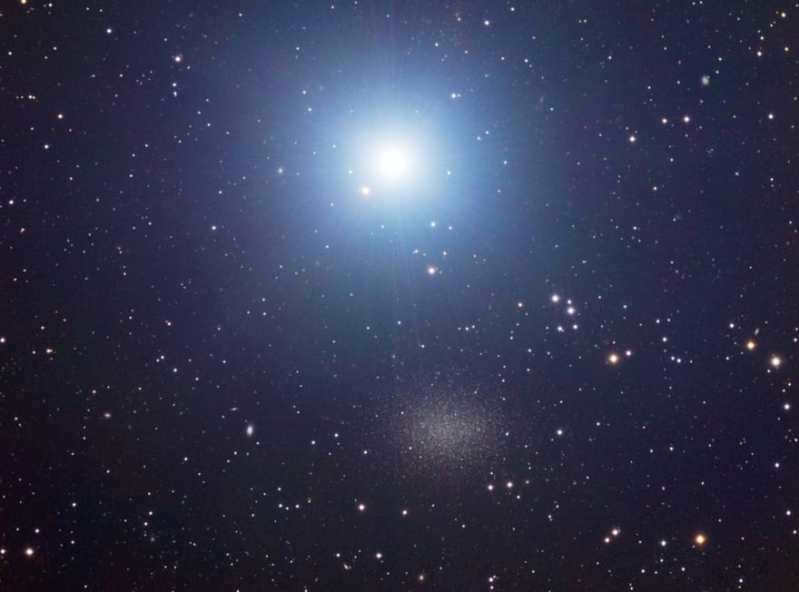
You can spot Regulus B using binoculars, but to catch a glimpse of C, you’ll need a powerful telescope. To make your search easier, take advantage of our online star map or a 3D model that illustrates the movement of Regulus through space.
Regulus is visible year-round, except in August when the Sun comes close to its apparent position. Heliacal ascension occurs during the first week of September. Once every 8 years, Venus aligns with Regulus. The ideal viewing time from the northern hemisphere is during winter and early spring.
Fascinating Details
So, you’re familiar with the constellation that Regulus is a part of. Let’s delve deeper into the star’s characteristics, such as its vibrant hue, precise coordinates, and intriguing tidbits.
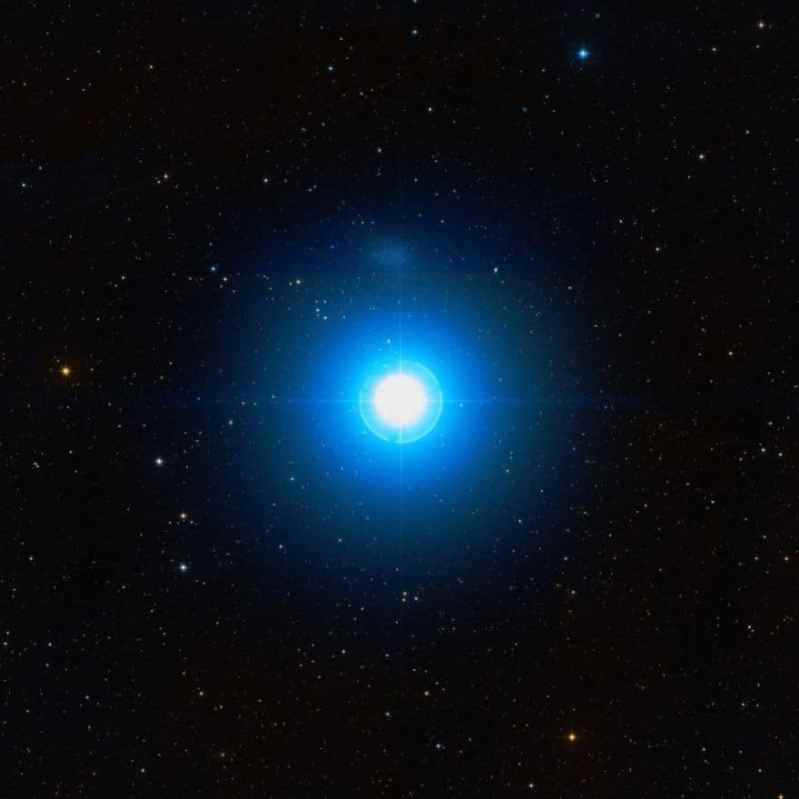
Regulus is positioned 0.46 degrees above the ecliptic and is frequently obscured by the Moon. On occasion, it is also concealed by Mercury and Venus. The most recent overlap with Venus occurred in 1959, and the next one is projected to take place in 2044.
Alpha Leo sometimes attracts asteroids towards itself. In 2014, the star was visited by 163 Erigon, a 73-kilometer wide asteroid from the asteroid belt. Additionally, in 2005, the star was approached by 166 Rodol, which measures 54.6 kilometers in diameter.
Regulus has been recognized by various cultures throughout history. The contemporary name originates from the Latin word “rex,” meaning “king.” This particular designation was chosen by Nicolaus Copernicus. The Arabs referred to it as Kalb al-Asadu, which translates to “the heart of the Lion.”
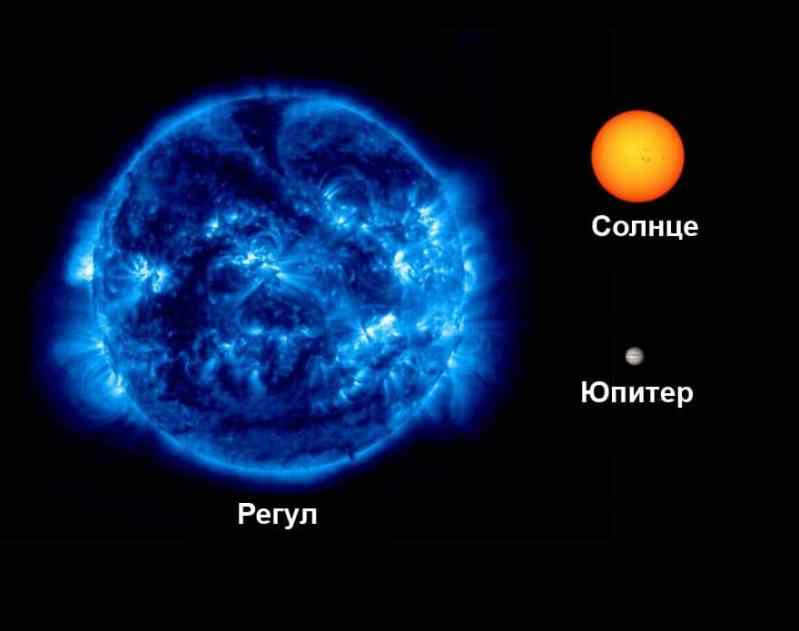
Comparing the sizes of Regulus, the Sun, and Jupiter
Regulus was known as Sharru (King) in Babylon, Miyan (Center) among the Persians, and Magha (Mighty) in India. During the medieval era, Regulus was considered one of the 15 fixed stars of Begen, which had an influence on several planets.
This star has been referenced in various films such as Babylon 5, Star Trek, as well as in computer games like BattleTech and Frontier: Elite II.
Stellar System
The Regulus system consists of four elements and two pairs. The more luminous component is referred to as Regulus A, which is a binary star system consisting of a blue star and its white companion. The two stars orbit each other every 40.11 days and are separated by a distance of 0.35 astronomical units. The existence of the companion star was first observed in 2008.
Regulus A’s primary component has a mass 3.8 times that of the sun and is estimated to be a few million years old. It rotates rapidly at a speed of 347 km/s. Its rotational period is 15.9 hours, which has caused the star to become oblate in shape, with its equatorial diameter being 32% larger than its polar diameter. If the star were rotating 10% faster, it would disintegrate due to insufficient gravitational force. Consequently, the star’s poles are five times brighter and hotter than its equatorial region.
The second set is called Regulus B and C, representing the dim stars of the primary sequence (K1-2 V and M5 V). These stars are orange and red dwarfs situated in the forefront. The duration of their orbit is 2000 years, and the distance between them reaches 100 astronomical units. Regulus C is positioned 177 angular seconds away from A.
Regulus, located in the Leo constellation, moves quickly across the sky. It is a component of the Leo’s Sickle asterism and indicates the lower part of the handle. In terms of shape, this asterism resembles an inverted question mark. To locate it, one can utilize the stars of the Big Bucket in the Big Dipper constellation. Megretz and Thekda act as guides towards its position.
Regulus, the Brightest Star
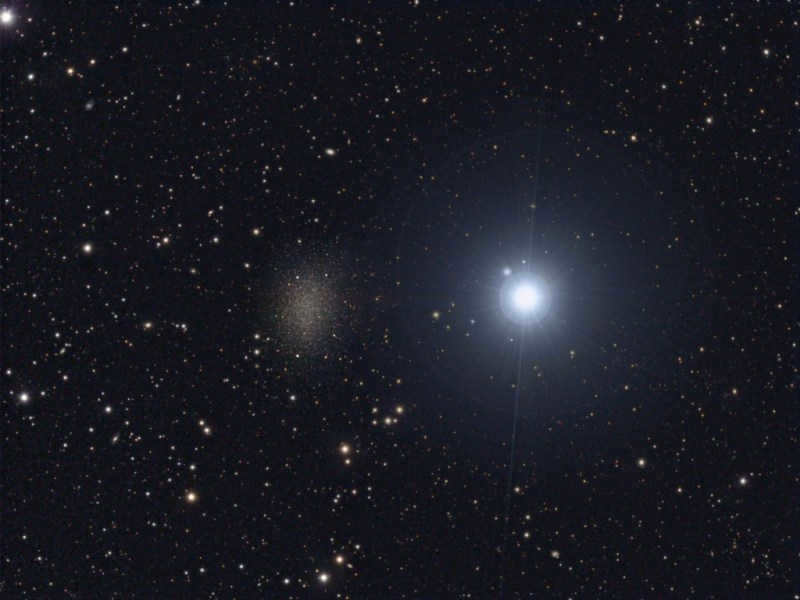
When gazing at the night sky in spring, one cannot help but notice three prominent stars – Arcturus, Spica, and Regulus.
Regulus, the prince of the celestial realm
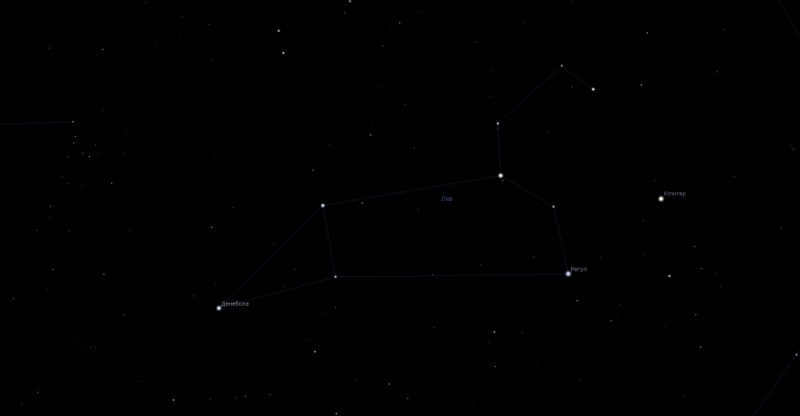
The constellation Leo is home to the prominent star known as Regulus. This celestial body, also referred to as Alpha of the Leo constellation, shines brightly in the night sky. It is particularly visible during the spring season when the sky is less crowded with other luminous stars compared to the summer months. However, observing Regulus in the summer can present some challenges due to its proximity to the ecliptic, which is the path of the Sun in the sky. At times, the Moon may obstruct the view of this remarkable star.
The Leo constellation – the primary constellation in the sky during the spring season
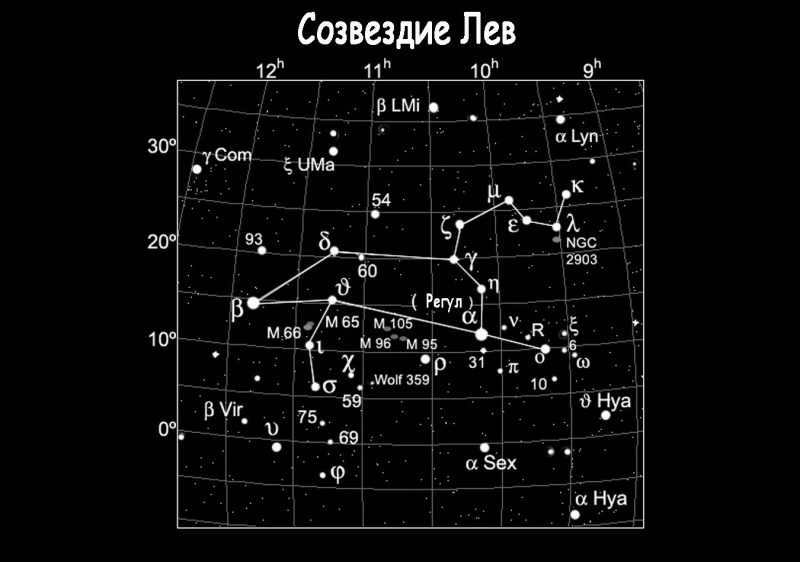
However, during the spring season, when Regulus is situated at a considerable distance from the ecliptic, it can be readily distinguished amidst the numerous celestial bodies, even with unaided vision. This is primarily due to the extraordinary luminosity exhibited by this particular star.
Etymology and Discovery History
Being the 21st most luminous star visible in the Northern Hemisphere, Regulus stands out prominently in the night sky. Unsurprisingly, a star of such brilliance could not escape notice for long. The earliest mention of Regulus can be traced back to ancient Arabic manuscripts, dating back several centuries before the Common Era. In these texts, the star is referred to as “Kalb Al-Asad”, which translates to “the heart of a lion” in Russian. However, the name Regulus itself originates from the Latin language. It was European astronomers who first bestowed the moniker “Regulus” upon it, a name that is now recognized worldwide. In Latin, “regulus” means “prince” or “little king”. Indeed, gazing upon this radiant star, one can easily envision an Arabian prince striding proudly alongside the Lion.
The star’s unconventional form and rapid rotation
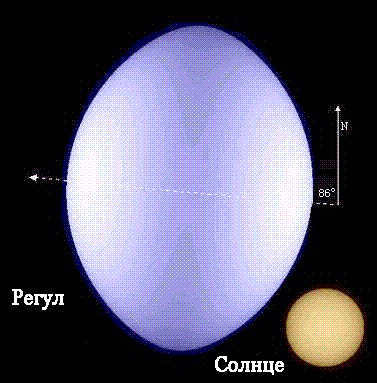
Amateur stargazers have a primary fascination with the star Regulus due to its incredible luminosity and unique structure. Unlike our Sun, which rotates at a leisurely pace, Regulus spins at a mind-boggling speed of 315 km/s. This rapid rotation causes the star to take on a flattened shape, with its equatorial radius measuring almost one-third larger than its polar radius. Fascinatingly, Regulus completes a full revolution on its axis in less than 16 hours. What’s even more intriguing is that if Regulus were to rotate just 14 percent faster, reaching a staggering speed of 359.1 km/s, the star’s centripetal force of gravity would be insufficient to hold it together, resulting in its disintegration.
Regulus, unlike most stars, has an inclined rotation axis, which gives us the unique perspective of observing this celestial body from its edge. The high rotation speed of Regulus results in the poles being approximately half as hot as the equator and five times brighter. Interestingly, the axis of rotation of Regulus aligns with its orbital line, causing the star to move along its orbit as if it were on its side. This phenomenon is a fascinating astronomical observation.
Weight and years
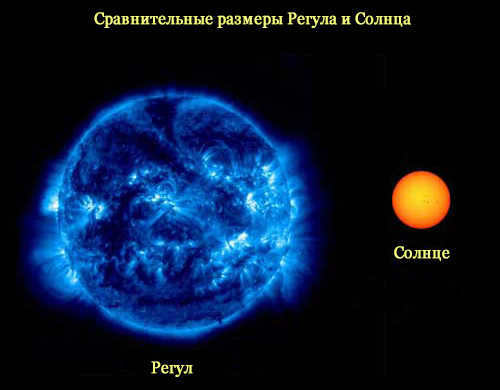
What constellation is the star Regulus in?
Regulus is considered to be a fairly massive star according to calculations made by modern physicists and astronomers. It is widely accepted that Regulus has a mass three and a half times that of the Sun.
There has been some debate among scientists regarding the age of Regulus. Previously, it was believed to be no more than 100 million years old, indicating a young star. However, in 2008, the discovery of a dwarf star, Regulus D, near Regulus challenged this belief. The close proximity of Regulus D led scientists to speculate that Regulus is actually much older than previously thought.
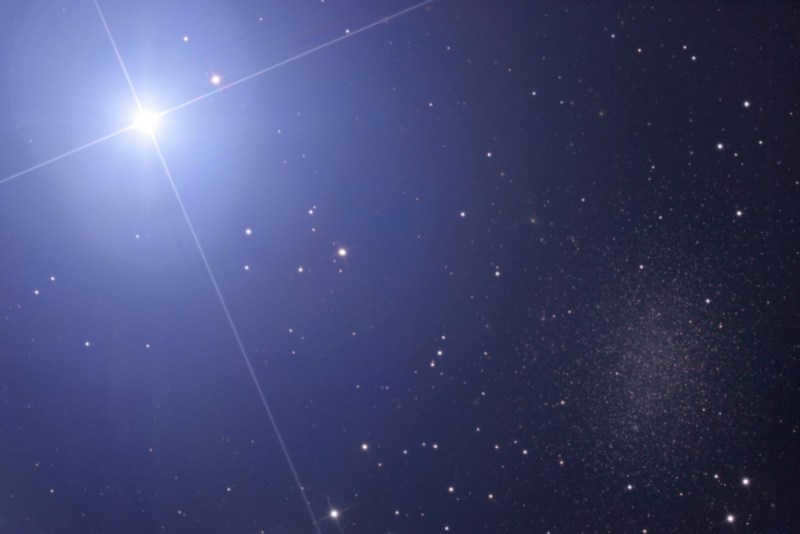
Identifying Regulus in the Night Sky
Locating Regulus is a simple task due to its status as one of the most brilliant stars in the night sky. Situated within the Leo constellation, Regulus also serves as the foundation for the renowned asterism known as the Sickle, which can be easily observed in the Northern Hemisphere. All you need to do is tilt your head upwards, and you will be greeted with a collection of stars that form the shape of a sickle or an inverted question mark. At the base of this distinctive pattern lies Regulus, shining brightly.
Compilation of the most brilliant celestial bodies
| 0 | The Sun | 0.0000158 | -26.72 | 4.8 | G2V | |
| 1 | Sirius (Alpha Canis Majoris) | 8.6 | -1.46 | 1.4 | A1Vm | South |
| 2 | Canopus (Alpha Carinae) | 310 | -0.72 | -5.53 | A9II | South |
| 3 | Alpha Centauri | 4.3 | -0.27 | 4.06 | G2V+K1V | South |
| 4 | Arcturus (Alpha Bootis) | 34 | -0.04 | -0.3 | K1.5IIIp | North |
| 5 | Vega (Alpha Lyrae) | 25 | 0.03 (permanent) | 0.6 | A0Va | North |
| 6 | Capella (Alpha Aurigae) | 41 | 0.08 | -0.5 | G6III + G2III | North |
| 7 | Rigel (Beta Orionis) |
Alpha Leo, also known as 32 Leo, Cor Leonis, Basilicus, Lion’s Heart, Rex, Al Kalb al Asad, Kabeleced, GJ 9316, HR 3982, BD +12° 2149/2147, HD 87901/87884, GCTP 2384.00, LTT 12716/12714, SAO 98967/98966, FK5 380, and HIP 49669.
Regulus (α Leo / α Leo / Alpha Leo / Regulus / Alpha Leonis / α Leonis / Alpha Leo) stands out as the most brilliant star in the Leo constellation and one of the most luminous stars in the nighttime sky. Situated approximately 77.5 light-years away from our solar system, Regulus has captivated astronomers for centuries. In the ancient Arabic language, this celestial body was known as Kalb Al Asad (قلب الأسد), which can be translated as the “heart of the lion.” In certain instances, it has also been referred to as Cor Leonis in Latin. In the realm of ancient Indian astronomy, Regulus corresponds to the Nakshatra Magha. Alpha Leo is regarded as the final star on the list of first magnitude stars, as the next brightest star, Adara, possesses a stellar magnitude of 1.50 m, classifying it as a second magnitude star. Out of all the brightest stars in the sky, Regulus comes closest to the ecliptic, with the Sun coming into its nearest proximity around August 23rd each year. This proximity also means that Regulus is occasionally obscured by the Moon.
Characteristics [ edit ]
Distinctive features
Unique qualities
Specific traits
Individual attributes
Notable characteristics
Remarkable properties
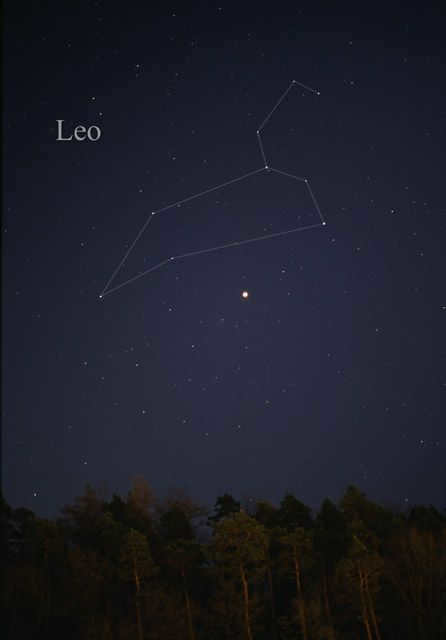
The star possesses a binary system consisting of two faint, small companions. These stars are separated by a distance of approximately 100 astronomical units (a.u.) and revolve around their shared center of gravity every 2000 years. This binary system is located at a significant distance from the massive Regulus A, approximately 4200 a.u., and completes a full orbit around the host star every 130 thousand years.

Arrangement of the Local Bubble. The arrangement of Regulus, the Sun, and other celestial bodies is illustrated. The picture is positioned in such a way that the stars nearest to the center of the Milky Way galaxy are at its highest point.
At a distance of 20 arc minutes [2] in the northern sky from Regulus, the dwarf spheroidal galaxy Leo I, which accompanies our Milky Way galaxy, can be seen.
Investigation [ edit ]
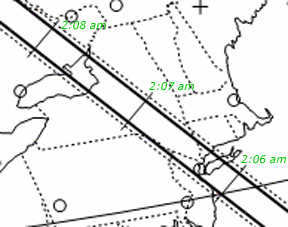
In mid-April 2011, researchers at the University of Michigan were able to capture images and gather data about Regulus using an advanced optical instrument that combined light from four telescopes, making it appear as if it came from a telescope that was a hundred times larger. Additionally, they debunked the Von Zeipel theorem, a long-standing theory that had been around for nearly a century [3].
On March 20, 2014, the star Regulus was obscured by the asteroid (163) Erigona, and this event was observed in a specific area over the North Atlantic and North America [4].
During the period of March 9, 2021, from 20:08 to 20:23 World Time, there was a momentary coverage of the star Regulus by the 9-kilometer asteroid (2589) Daniel (+16.9 m). The maximum duration of this coverage lasted for about 1 second.
Notes [ edit ]
- ↑McAlister, H. A. et al.First results from the CHARA radio array. Interferometric and spectroscopic study of the fast-rotating star α Leo (Regulus) = First Results from the CHARA Array. I. An Interferometric and Spectroscopic Study of the Fast Rotator α Leonis (Regulus) // The Astrophysical Journal. – IOP Publishing, 2005. – Vol. 628 , iss. 1 , no. 7 . – P. 439-452 . – doi:10.1086/430730.
- ↑Two-thirds of the Moon’s visible surface
- ↑Surface imaging of a star disproved an ancient law(link unavailable): [arch. 24.04.2011]. – Date of access: 20.04.2011.
- ↑An asteroid eclipse occurred on November 26, 2020. A copy is archived at the Wayback Machine. Space.com 2014 March 20





